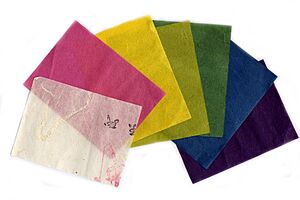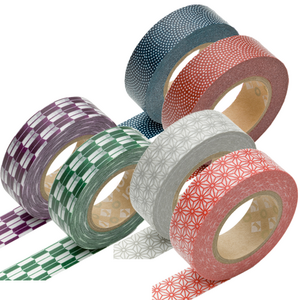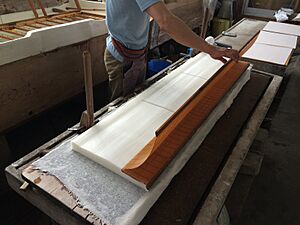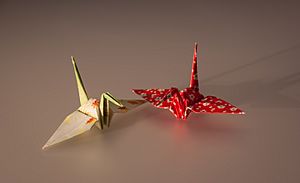Washi facts for kids
Washi (和紙), sometimes called rice paper, is a special kind of traditional Japanese paper. It is made by hand using strong fibers from the inner bark of plants. These plants include the gampi tree, the mitsumata shrub, or the paper mulberry (kōzo) bush.
Washi is usually much tougher than regular paper made from wood pulp. Because of its strength, it is used in many traditional Japanese arts. For example, Origami (paper folding), shodō (calligraphy), and ukiyo-e (woodblock prints) all used washi. This amazing paper was also used to make everyday items like clothes, household goods, and toys. Even special robes and objects for Shinto priests and Buddha statues were made from it. Washi was even used to create wreaths for winners at the 1998 Winter Paralympics. Today, museums like the Louvre and the Vatican Museums use washi to repair old paintings, books, and other valuable cultural items. This is because it is thin, flexible, very durable (lasting over 1000 years), and easy to work with.
As a unique Japanese craft, washi is recognized by UNESCO as an intangible cultural heritage.
Contents
A Journey Through Time: Washi's History
Paper first arrived in Japan from China around the 600s, traveling through the Korean Peninsula. However, the Japanese didn't just copy the method. They made paper-making even better during the Heian period (794-1185 AD). Around 805 to 809 AD, they developed a technique called nagashi-suki (流し漉き). This method involved adding a special sticky substance, called mucilage, to the paper-making process. This made the paper fibers form a much stronger layer.
The improved washi became very important for religious ceremonies. It was used to decorate Shinto shrines with items like gohei, ōnusa, and shide. During the Heian period, washi was also used to create beautiful books, such as the Kokin Wakashu, which were often decorated with gold and silver leaf.
How Washi Changed Art and Life
In the Muromachi period (1336-1573 AD), washi became part of ceremonial origami. This was used by the samurai class for special occasions like weddings or when giving gifts. Later, from the Sengoku period (1467-1615 AD) to the Edo period (1603-1868 AD), fun recreational origami like orizuru (paper cranes) became popular. During the Edo period, many books and ukiyo-e prints for everyday people were made using washi and woodblock printing.
How Washi is Made
Making washi is a detailed process that relies heavily on handcrafting. It involves many steps and is often done in the cold winter months. This is because pure, cold running water is essential for making the best washi. Cold water helps stop bacteria from breaking down the plant fibers. It also makes the fibers shrink a little, giving the paper a crisp feel. Traditionally, making washi was a winter job for farmers, helping them earn extra money.
The Special Ingredients
The most common plant fiber used for Japanese paper is the paper mulberry. First, the mulberry branches are boiled. Then, their outer bark is carefully stripped off, and the fibers are dried. Next, these fibers are boiled again with lye (a strong soap) to remove things like starch, fat, and tannin. After this, the fibers are placed in running water to wash away the lye. Sometimes, the fibers are bleached (either with chemicals or naturally in a stream). Any remaining tiny impurities are picked out by hand. Finally, the clean fibers are laid on a rock or board and beaten to make them soft and ready.
Crafting the Paper Sheets
Wet balls of the prepared pulp are mixed in a large vat with water. A special helper ingredient is added to keep the long fibers spread out evenly. This helper is traditionally neri, a sticky material made from the roots of the tororo aoi plant. Sometimes, PEO (polyethylene oxide) is used instead.
There are two main traditional methods for making the paper sheets: nagashi-zuki or tame-zuki. In both methods, pulp is scooped onto a screen and gently shaken. This helps the fibers spread evenly across the screen. The nagashi-zuki method, which uses neri, creates thinner paper. The tame-zuki method, which does not use neri, makes thicker paper.
Different Kinds of Washi
With enough effort, almost any grass or tree can be used to make washi. However, gampi, mitsumata, and paper mulberry are three popular choices.
- Ganpishi (雁皮紙): In ancient times, this was called Hishi (斐紙). Ganpishi has a smooth, shiny surface. It is often used for making books and various crafts.
- Kōzogami (楮紙): Kōzogami is made from paper mulberry and is the most common type of washi. It is incredibly tough, almost like cloth, and stays strong even when treated to be water-resistant.
- Mitsumatagami (三椏紙): Made from the mitsumata plant, mitsumatagami has a fine, ivory-colored surface. It is used for shodō and for printing. This type of washi has been used to print paper money since the Meiji period (1868-1912 AD) and is still used today.
Where Washi is Used Today
Until the early 1900s, Japanese people used washi for almost everything that Western-style paper or other materials are used for today. This was partly because washi was the only paper available in Japan at the time. However, it was also because washi's unique qualities made it a better material for many tasks.
Today, washi is still used in some special ways, such as in watch dials.
See also
- Genkō yōshi
- kaishi(ja:懐紙)
- Japanese tissue
- Sir Harry Parkes
- Tissue paper
- Ukiyo-e
- List of Traditional Crafts of Japan





